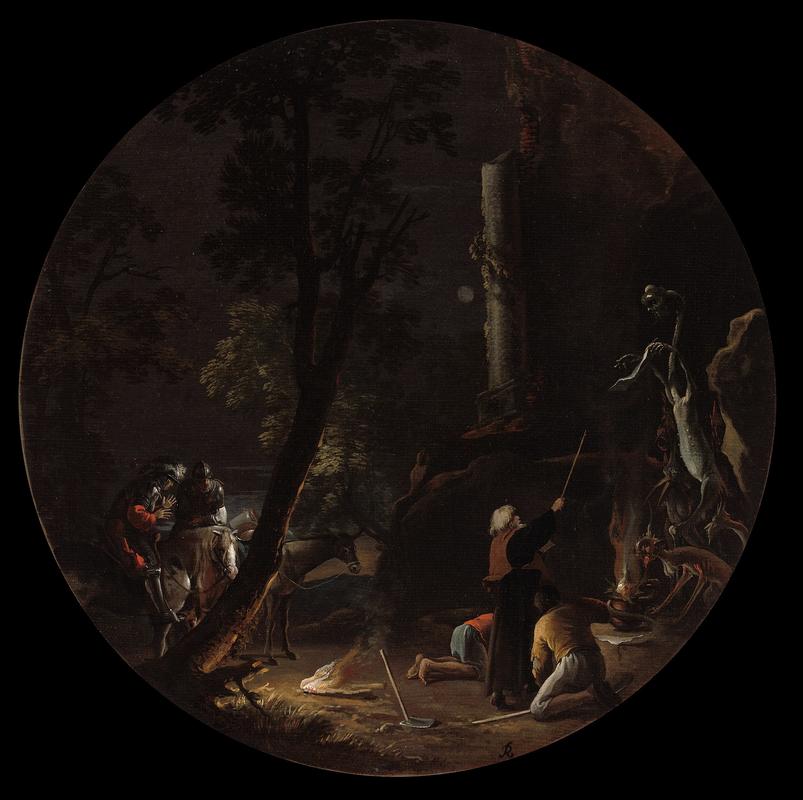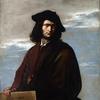More about Scenes of Witchcraft: Night

Contributor
Salvator Rosa made this series of paintings called Scenes of Witchcraft in Florence in the Medici Court, directly during the peak of the witch hunt craze in Europe.
Each of his four circular paintings (called tondi) depict scenes of magic being carried out by witches and sorcerers. Their magic ranges in action from a witch impaling a monstrous frog with a sword, to preparation of a witch orgy potion for an epic rager at Sabbath, to a desperate love potion brewing. These first three, whether intentionally or not, played especially intensely into the witch craze of the 1600s. They portrayed female witches engaging in magic during a time when the Pope and the Catholic Church targeted primarily elderly women, widows, and women selling herbs, and then tried them with severe punishment (usually burning at the stake). Overall, seventy percent of those tried as witches were women. And since many women were widows, they were left essentially without defense in trial. Over the course of two-hundred years, it’s estimated that between forty and sixty thousand people were executed, most of whom were women.
However, this last tondi stands out as clearly different from the other three in the series. Sure, everything is dark, there are creatures you’d never want to run into in a dark alley or even a nightmare for that matter, and there’s magic. But, it’s a single man standing up tall and proud to a creature of death, wand poised in the air, as opposed to groups of naked women. Interestingly enough, art historians even made a connection between the figure in this painting and depictions of the biblical Moses, who was a strong influence on depictions of male sorcerers.
Many people have also speculated that the figure of the sorcerer may be a representation of Rosa himself. The evidence cited most often is the fact that he signed the painting directly below that figure (which of course is not evidence enough on its own!). But the evidence that’s a bit stronger, and definitely more interesting, comes in the form of his letters to the poet and philosopher GB Ricciardi. In these letters, Rosa declares time and again that he sees himself as exceptional from other people and artists. He continues, saying that because he is exceptional he deserves the creative license to produce whatever inspiration comes to him. He was especially proud of his imagination and creative genius. In other words, the conspiracy theory I’m offering here (based on opinions of others) is that the way Rosa sees his own genius is in alignment with the way he sees and depicts this male sorcerer here...or, as the Cleveland Museum puts it, “Just as a powerful magician could conjure strange creatures with his wand, so too could Rosa shape a strange world with his originality, intelligence, and the skillful use of paint and brush.”
Sources
- Anonymous. "Scenes of Witchcraft: Night." Cleveland Museum of Art. January 21, 2019. Accessed July 12, 2019. https://clevelandart.org/art/1977.37.4.
- Bailey, Michael D. "Brian P. Levack. The Witch-Hunt in Early Modern Europe." Magic, Ritual, and Witchcraft 2, no. 1 (2007): 101+. Academic OneFile (accessed July 12, 2019). http://link.galegroup.com.libproxy.newschool.edu/apps/doc/A166309554/AO…
- Kmiers. "The Novel and the Bizarre: Salvator Rosa's Scenes of Witchcraft." Cleveland Museum of Art. June 01, 2015. Accessed July 12, 2019. https://www.clevelandart.org/exhibitions/novel-and-bizarre-salvator-ros….
- Salerno, Luigi, and Ira Kohn. "Four Witchcraft Scenes by Salvator Rosa." The Bulletin of the Cleveland Museum of Art 65, no. 7 (1978): 225-31. http://www.jstor.org.libproxy.newschool.edu/stable/25159591.
- Stratton, Kimberly B. Naming the Witch: Magic, Ideology, and Stereotype in the Ancient World. New York: Columbia University Press, 2007.
- Tal, Guy. "Witches on Top: Magic, Power, and Imagination in the Art of Early Modern Italy." Order No. 3230548, Indiana University, 2006. https://login.libproxy.newschool.edu/login?url=https://search-proquest-…
- Wallace, Richard W. "The Genius of Salvator Rosa." The Art Bulletin 47, no. 4 (1965): 471-80. doi:10.2307/3048305.











